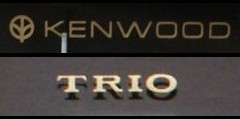Japan made stereo tube receivers
|
|||||||
|
Japan after the Second World War was a
relatively poor country. The development of electronics in the
luxury segment (and such were tube stereos) had to be financed by
exports. It started at the beginning of the 1950s and in the
second half of the decade the share of Japanese products in the
American market was significant. Japanese electronics were also
sold through the US military's PX military chain located in
foreign bases. This export was dominated by three companies -
Sansui, Pioneer and Trio (known as Kenwood). Their products
differed from each other in terms of the electronic solutions used
and the characteristic design, but they had similar features.
First of all, the price. Japanese products were much cheaper than
their American counterparts. This was due to cheaper labor,
equipment design and components used. For example, Japanese
companies have always used steel sheets of various qualities for
the chassis, which tend to corrode under unfavorable conditions.
However, some products had galvanized sheets. The housing was
always made of metal. Air mounting, in accordance with the rules
of this type of mounting, but less precise than in American
products. The components were definitely distinguished by Japanese
products. All tubes were domestic production companies as NEC,
TOSHIBA, HITACHI or MATSUTSHITA; no import. And the tubes had the
logo of their manufacturer, not of the device producer. Compliment
of used tubes matched American and European ones with exceptions.
Very often the driver tubes were 6AN8 double lamps, similar in
construction to the European ECF80 / 82 series tubes, but nowhere,
except in Japan and the USA, not produced and not used. A typical
Japanese lamp was the "magic eye" 6R-E13 without a foreign
replacement. Other components are also Japanese products. ELNA
electrolytic capacitors, ELNA and SUZUKI coupling caps. Oil-type
coupling capacitors were specific to their design. These
capacitors performed well in the working circuits, but they got
leakage after a longer idle time. When turned on, they could
damage the lamps and sometimes suddenly destroyed. The same
applied to the small size of electrolytic capacitors (therefore,
when starting the equipment, it is necessary to check whether the
capacitors are to be replaced). What appears to be a "cheaper" solution sometimes turns out to be quite a good solution in other circumstances. And so, all metal structures of the devices were more durable, resistant to shocks and impacts, which was important in transport. Iron is harder than aluminum, which dominated American hardware. And another element that significantly improved utility properties in Europe. Power supply with voltage 220 / 230V. Americans did not treat Europe as a market for their products (because the EU was still poor in the 1960s), therefore they produced the overwhelming majority of their products only on 110V voltage. The Japanese, trying to produce products all over the world, equipped most of their products with voltage switches. It should also be added that a large part of the Japanese production was sold in the PX stores of the American army. Several hundred thousand American soldiers were a significant "army" of customers, and the 1960s differs from today in that all young people wanted to have a stereo (now a laptop). And in terms of price, Japanese equipment was easier for conscripts and salaried savers. . The Japanese also entered the segments less developed by the Americans. Japanese products were the smallest in terms of size and power. Several dozen models of receivers using ECL82 tubes working in the Push & Pull class were exported from the country of the blooming cherry trees, but there were also devices using these tubes working in the SE class. Some of the models used ECL86 lamps. However, the most common models were based on EL84 lamps in the PP class. The highest class of receivers were a pair of models based on the more powerful and very popular in the US audio pentodes 7591 and its 7868 Novar version. The tube “decade” of stereo ended in 1971 with the end of production of the 1000A model. Later, only transistor devices were produced. |
||||||
L.A.2008
Visits



